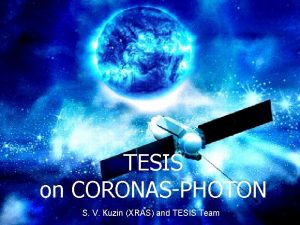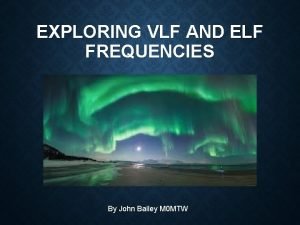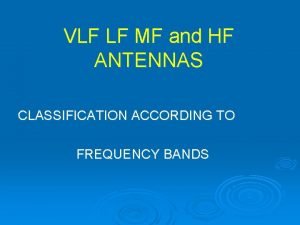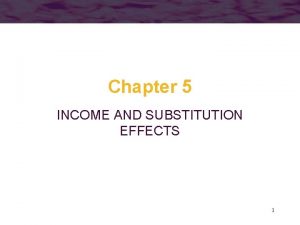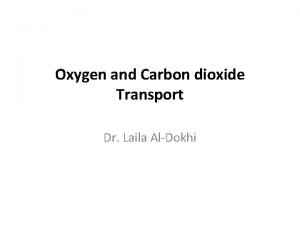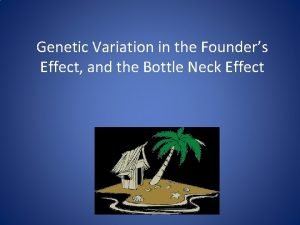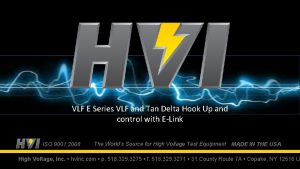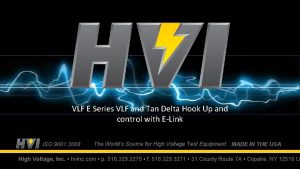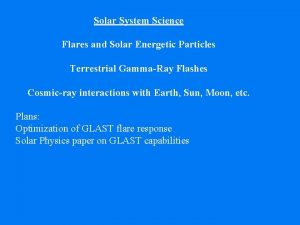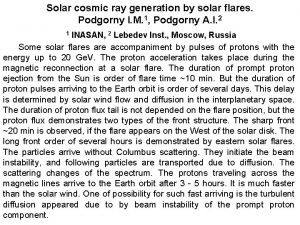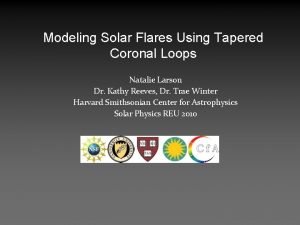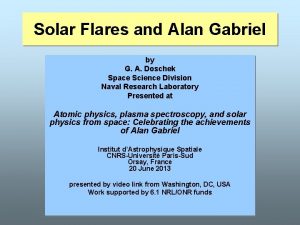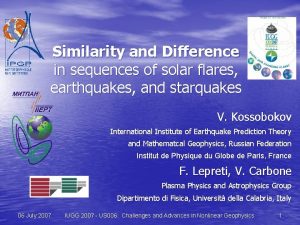The Effect of Solar Flares on the VLF

















- Slides: 17

The Effect of Solar Flares on the VLF Radio Waves transmitted in the Ionosphere A basic understanding -Sharad Khanal

SIDs and SID Monitor Program • Sudden Ionospheric Disturbance (SID) - Sudden increase in ion density in the ionosphere due to solar flares Graph: A typical SID data plot

SIDs and SID Monitor Program • Monitor SIDs by monitoring VLF waves transmitted through the ionosphere • BASIC IDEA – Monitoring the VLF waves means monitoring the ion disturbances in the ionosphere However, the disturbances could be caused by other phenomena such as gamma ray bursts as well.

The SID detector and all that • All the details on the webpage www. solar-center. stanford. edu/sun/sid. html

The Ionosphere • Layers of atmosphere – – Troposphere (8 -15 kms) Stratosphere (-50 kms) Mesosphere (-85 kms) Thermosphere (-600 kms) Ionosphere (70 kms - )

Ionosphere – Regions • Different Regions of the Ionosphere – – – D (70 - 90 kms, ionized by X-rays 0. 1 -1 nm) E (100 - 120 kms, ionized by EUV 80 -103 nm and X-rays 1 -20 nm ) F (forms F 1 and F 2 layers during the day) (ionized by EUV 20 -80 nm) http: //www. sel. noaa. gov/info/Iono. pdf

Ionosphere – D Layer Properties • 70 -90 kms (Parts of Stratosphere, Mesosphere and Thermosphere) • Temperature – about 190 K • Ionization Properties – – Usually about 1000 electron/cm 3 – Ions present – O+, N 2+, O 2+, NO+

Ionosphere – D Layer Properties • Photo-Chemical Reactions – Photo Ionization • O + hv O + + e • N 2 + hv N 2+ + e • O 2 + hv O 2+ + e- hv = 13. 6 e. V hv = 15. 6 e. V hv = 12. 1 e. V – Molecular Ionization • O+ + O 2 + + O • O+ + N 2 NO+ + N • N 2+ + O NO+ + N – Recombination • NO+ + e- N + O • O 2 + + e - O + O • N 2 + + e - N + N • Present during the day – however, very low ionization 1000 e-/m 3 compared to 100, 000 e-/m 3 in E layer and 1, 000 e-/m 3 in the F layers.

Transmission of VLF through the Ionosphere • Radio waves reflected by the Ionosphere – acts like a mirror (because ions present in the Ionosphere) http: //www. tpub. com/neets/book 10/40 c. htm

Transmission of VLF through the Ionosphere • The waves are refracted by the differently ionized layers in the ionosphere – the combination of this refractive effects results in the reflection of the radio waves http: //www. ferzkopp. net/~aschiffler/Personal/Thesis/node 8. html

The Plasma Frequency • or the Maximum Useable Frequency (MUF) is the largest frequency that can be reflected by the ionosphere at vertical incidence f. N = 9√Nm where, f. N = MUF Nm = Ion Density • Ultimately depends on the ion density in the ionosphere

Transmission of VLF through the Ionosphere – regular day • When VLF transmitted, D layer is unable to reflect the wave as the ion density is not enough • So penetrates the D-layer, and reflects off the E and F layers • Loses energy while penetrating the D-layer Graph: A typical SID data plot

Transmission of VLF through the Ionosphere – regular night • At night, the D-layer disappears and only the F layer and sporadic E-layers are present • The signal strength increases as the wave no longer has to go through the D-layer Graph: A typical SID data plot

Transmission of VLF through the Ionosphere – during a SID • During a SID, a highly ionized D-layer forms in the Ionosphere • The ionization is now enough to reflect the VLF • Moreover, the wave does not have to lose its energy going through an extra ionized layer

Why –ve intensity? • Maybe due to the interference pattern?

Why –ve intensity?

Why –ve intensity? • Therefore, a simple interference pattern does not explain the inversed signals recorded • Possible causes? – Signal Detector Design – Phase changes upon reflection in the Ionosphere
 Tesis lebedev
Tesis lebedev Vlf receiver online
Vlf receiver online Vlf lf
Vlf lf Long bevel
Long bevel An inexhaustible source of energy
An inexhaustible source of energy Wholesalesolar.com/solar panels
Wholesalesolar.com/solar panels Slutsky equation
Slutsky equation Bohr effect in respiration
Bohr effect in respiration Founder effect vs bottleneck effect
Founder effect vs bottleneck effect Thiếu nhi thế giới liên hoan
Thiếu nhi thế giới liên hoan Khi nào hổ con có thể sống độc lập
Khi nào hổ con có thể sống độc lập điện thế nghỉ
điện thế nghỉ Thế nào là sự mỏi cơ
Thế nào là sự mỏi cơ Một số thể thơ truyền thống
Một số thể thơ truyền thống Trời xanh đây là của chúng ta thể thơ
Trời xanh đây là của chúng ta thể thơ Các số nguyên tố
Các số nguyên tố Tỉ lệ cơ thể trẻ em
Tỉ lệ cơ thể trẻ em Vẽ hình chiếu vuông góc của vật thể sau
Vẽ hình chiếu vuông góc của vật thể sau
